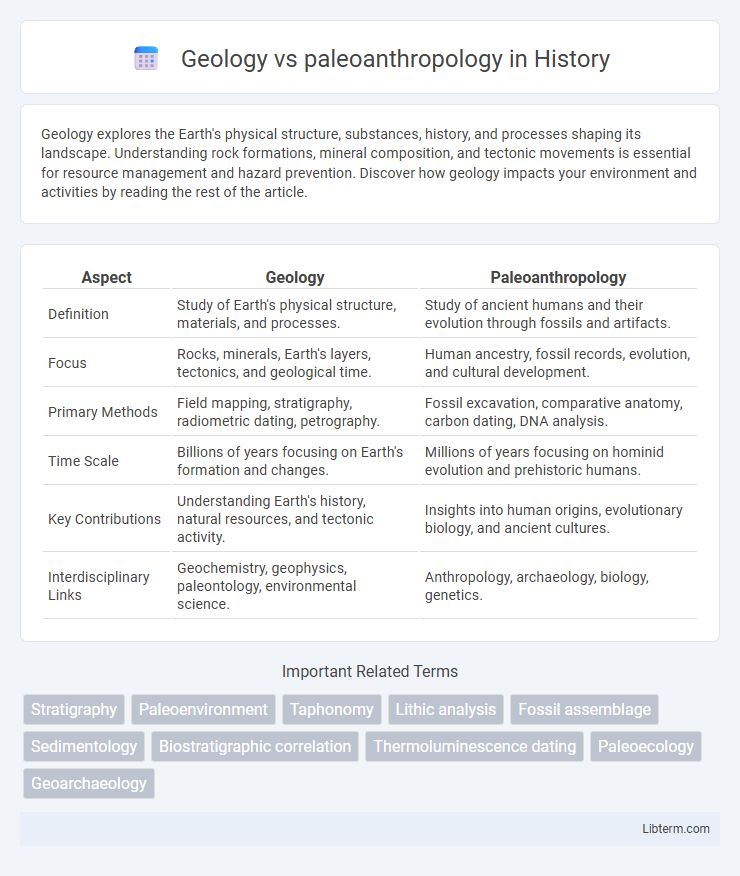Geology explores the Earth's physical structure, substances, history, and processes shaping its landscape. Understanding rock formations, mineral composition, and tectonic movements is essential for resource management and hazard prevention. Discover how geology impacts your environment and activities by reading the rest of the article.
Table of Comparison
| Aspect | Geology | Paleoanthropology |
|---|---|---|
| Definition | Study of Earth's physical structure, materials, and processes. | Study of ancient humans and their evolution through fossils and artifacts. |
| Focus | Rocks, minerals, Earth's layers, tectonics, and geological time. | Human ancestry, fossil records, evolution, and cultural development. |
| Primary Methods | Field mapping, stratigraphy, radiometric dating, petrography. | Fossil excavation, comparative anatomy, carbon dating, DNA analysis. |
| Time Scale | Billions of years focusing on Earth's formation and changes. | Millions of years focusing on hominid evolution and prehistoric humans. |
| Key Contributions | Understanding Earth's history, natural resources, and tectonic activity. | Insights into human origins, evolutionary biology, and ancient cultures. |
| Interdisciplinary Links | Geochemistry, geophysics, paleontology, environmental science. | Anthropology, archaeology, biology, genetics. |
Introduction to Geology and Paleoanthropology
Geology studies Earth's physical structure, materials, and processes, providing essential context for understanding ancient environments and fossil preservation. Paleoanthropology investigates human evolution through fossil remains, artifacts, and genetic data, relying heavily on geological frameworks to date and interpret findings. The integration of geology and paleoanthropology enhances insights into Earth's history and the origins of Homo sapiens.
Definitions and Core Concepts
Geology studies Earth's physical structure, materials, and processes including rock formation, plate tectonics, and sedimentation, focusing on the planet's history and dynamics. Paleoanthropology examines ancient human ancestors through fossil evidence, analyzing evolution, morphology, and behavior within an archaeological context. Both fields intersect in studying Earth's past environments but differ in focusing on geological phenomena versus human evolutionary biology.
Historical Development of Each Field
Geology emerged in the late 18th century with pioneers such as James Hutton and Charles Lyell, who established principles of stratigraphy and uniformitarianism that revolutionized understanding of Earth's history. Paleoanthropology developed later in the 19th and early 20th centuries, fueled by discoveries like the Neanderthal fossils in 1856 and the Piltdown Man in 1912, shaping the study of human evolution through comparative anatomy and archaeological evidence. Both fields evolved through key fossil finds and technological advances, with geology providing the temporal context essential for paleoanthropological research.
Research Methods and Tools
Geology employs stratigraphic analysis, radiometric dating, and remote sensing to study Earth's physical structure and history, utilizing tools like rock hammers, petrographic microscopes, and geophysical instruments. Paleoanthropology uses excavation techniques, morphometric analysis, and comparative anatomy to examine human fossils and artifacts, relying on tools such as trowels, 3D scanners, and CT imaging. Both fields integrate GIS technology and laboratory-based isotopic methods to enhance spatial analysis and chronological accuracy in their research.
Key Discoveries in Geology
Key discoveries in geology include the identification of plate tectonics, which revolutionized understanding of Earth's surface dynamics by explaining earthquakes, volcanic activity, and mountain formation. The discovery of radiometric dating methods enabled precise determination of the Earth's age and the timing of geological events. Stratigraphy played a crucial role in interpreting Earth's history through rock layers, providing a framework to correlate fossil records and past environmental changes.
Key Discoveries in Paleoanthropology
Paleoanthropology has revealed key discoveries such as the identification of Australopithecus afarensis, exemplified by the famous "Lucy" fossil, which provided crucial insights into early hominin bipedalism. The discovery of Homo naledi and the Denisovans has expanded understanding of human evolutionary diversity and interbreeding. These findings complement geology by contextualizing sediment layers and dating methods that establish the timeline of human evolution.
Interdisciplinary Connections
Geology provides critical insights into the Earth's stratigraphy, helping paleoanthropologists date fossil sites and reconstruct ancient environments where early humans lived. Techniques such as radiometric dating and sediment analysis allow for accurate temporal and environmental context vital for understanding hominin evolution. Interdisciplinary collaboration enhances interpretations of archaeological findings by integrating geological data with fossil records and paleoecological evidence.
Role in Understanding Human Evolution
Geology provides critical insights into human evolution by analyzing sediment layers, fossil dating, and environmental changes that shaped hominin habitats over millions of years. Paleoanthropology focuses on studying fossilized human ancestors, integrating anatomical, morphological, and cultural evidence to reconstruct evolutionary pathways. Together, geology and paleoanthropology create a comprehensive framework for understanding the timeline and context of human evolutionary history.
Challenges and Limitations
Geology and paleoanthropology both face significant challenges in dating and interpreting fossil records due to taphonomic processes and geological disturbances that can alter stratigraphy. Geologists must accurately reconstruct past environments and sedimentation patterns, which are often complicated by erosion or tectonic activity affecting rock layers. Paleoanthropologists encounter limitations in fossil preservation and sample scarcity, making it difficult to establish comprehensive evolutionary timelines or definitive behavioral conclusions.
Future Directions in Geology and Paleoanthropology
Future directions in geology emphasize integrating advanced remote sensing technology and machine learning algorithms to enhance subsurface mapping and resource exploration. In paleoanthropology, genome sequencing and 3D morphometric analysis are revolutionizing the understanding of hominin evolution and migration patterns. Interdisciplinary collaboration between geologists and paleoanthropologists is expanding, facilitating refined dating techniques and environmental reconstructions critical for contextualizing fossil records.
Geology Infographic

 libterm.com
libterm.com